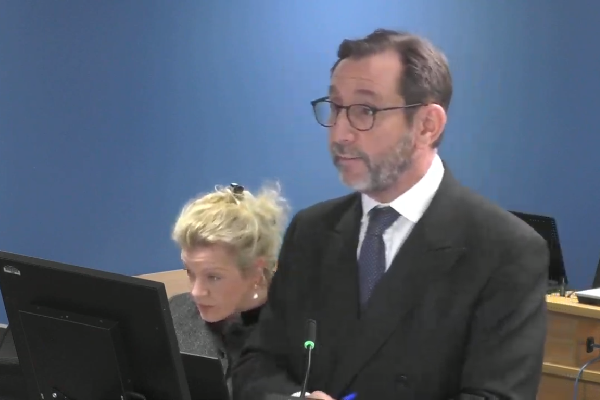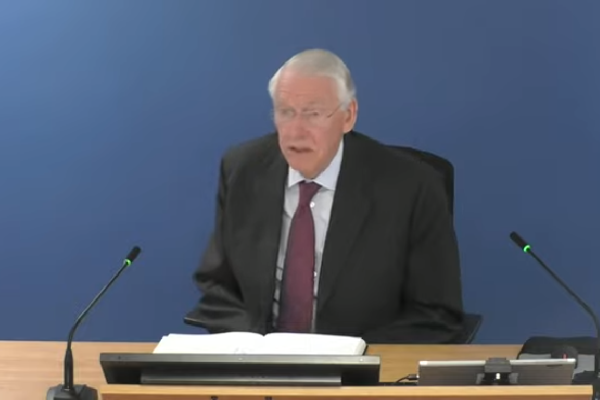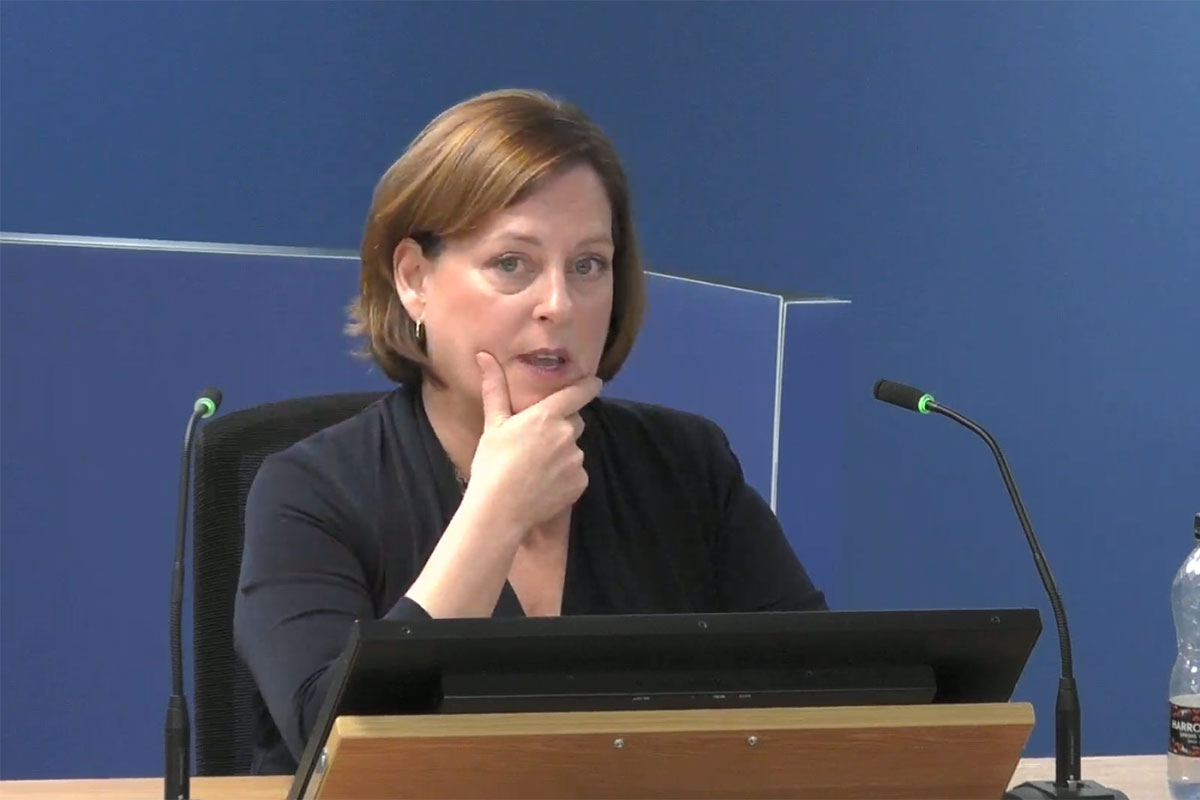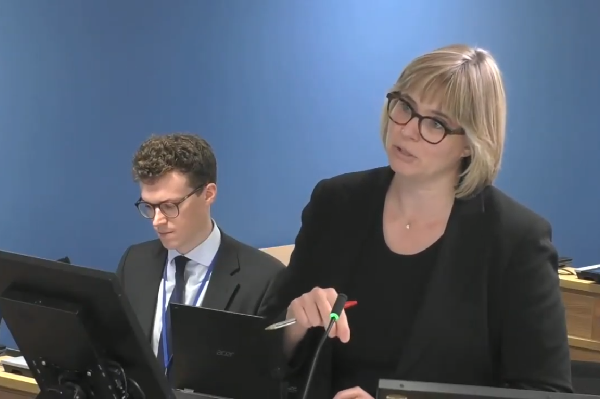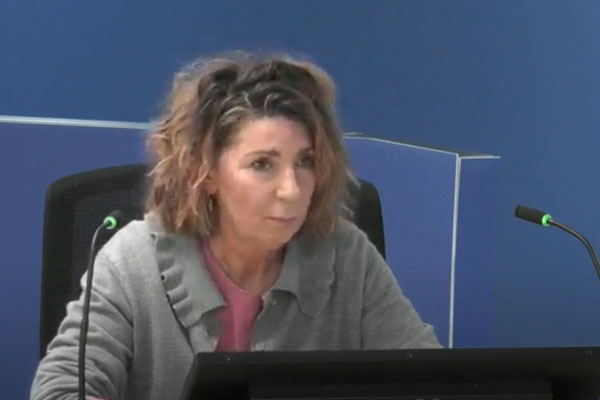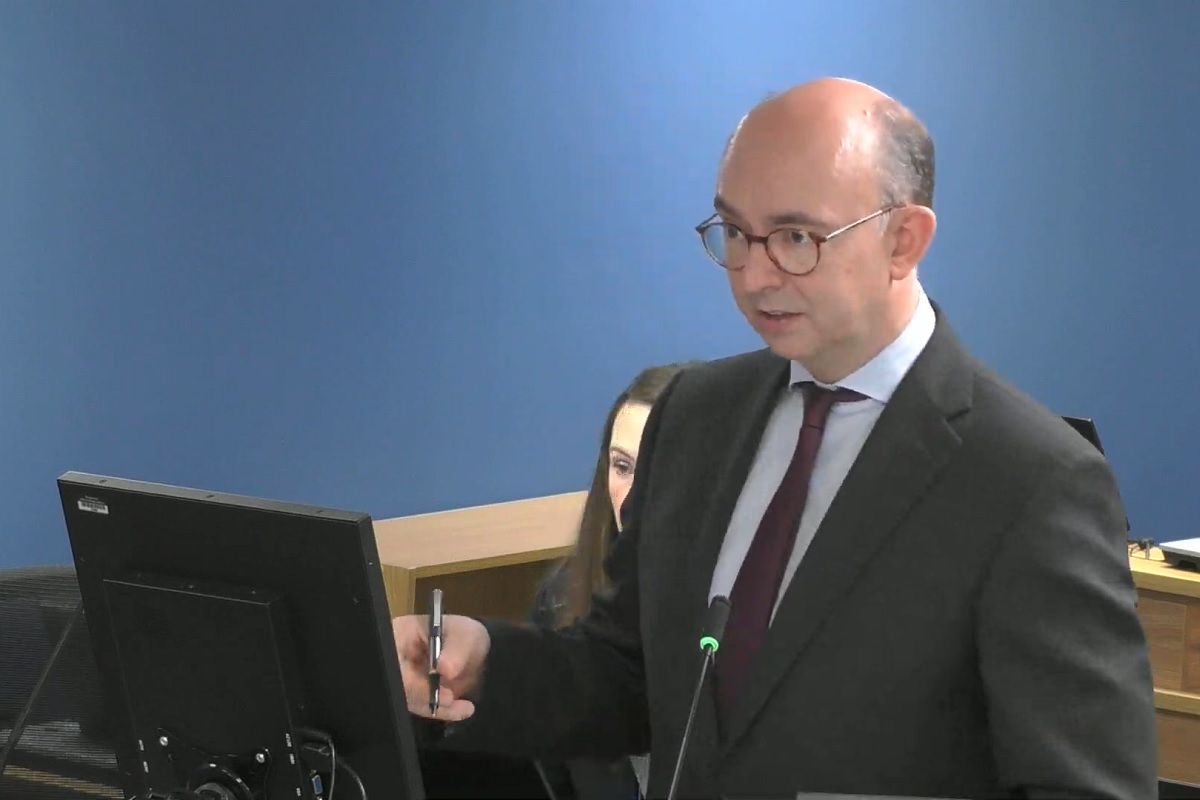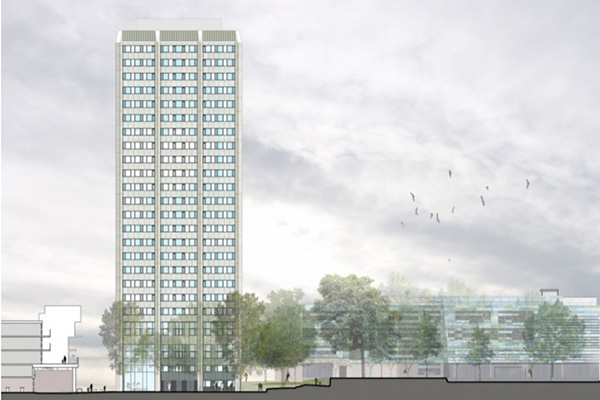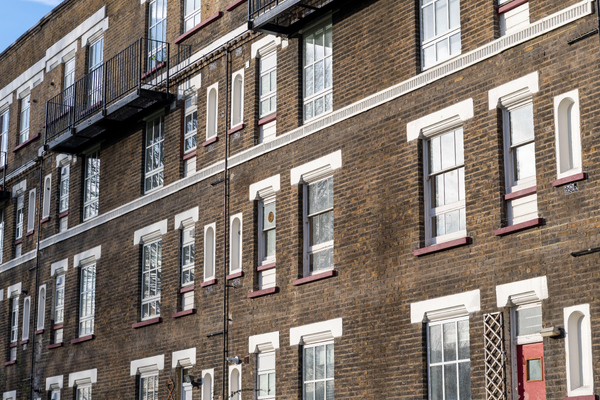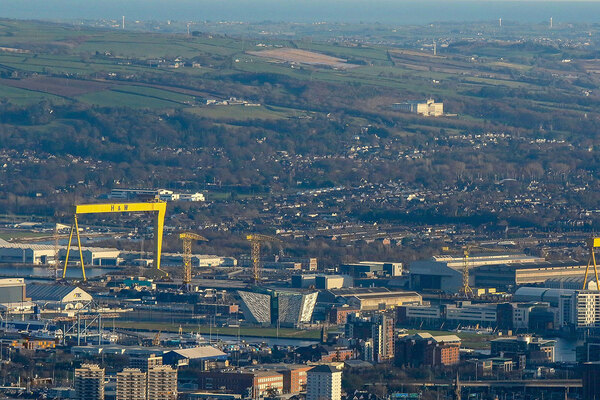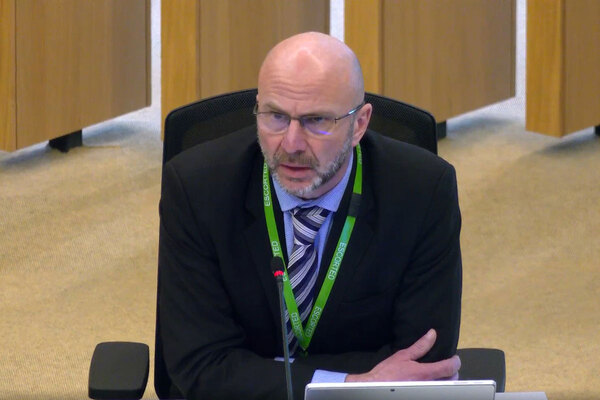Grenfell Tower Inquiry week 68: ‘Can we agree that was a pretty dangerous thing to have, all this falling on one man’s shoulders?’
Three senior civil servants gave evidence this week, including the official who had responsibility for building regulations guidance on fire safety in the years before Grenfell. Peter Apps, Lucie Heath, Stephen Delahunty and Grainne Cuffe report
This week, the inquiry continued to delve into the story of the government’s failures in the years before the tragedy.
Three important civil servants gave evidence, culminating with the opening evidence from Brian Martin – a man who many following this story have been waiting to hear from for some time.
We will begin our recap with his evidence.
Who is Brian Martin?
Mr Martin had been responsible for official building regulations guidance on fire safety for almost 18 years by the time of the Grenfell Tower fire.
He agreed when asked that he was the official with the greatest “breadth and depth of knowledge on the building regulations and guidance so far as it related to fire safety” and the person “to whom others would turn” to answer questions on the topic.
When she gave evidence on Wednesday, Melanie Dawes, the former permanent secretary at the Department for Communities and Local Government (DCLG), was asked if it was “pretty dangerous” to have the responsibility for all this “falling on one man’s shoulders”.
“Yes, I do. I think it ’s a single point of failure that had been allowed to be created,” she said. Asked to explain how this happened, she said it reflected budget cuts, the localism agenda and the fact that “regulation was not seen as something valuable, it was seen as something that created costs and burdens”.
“What was obviously becoming evident through those years was that the system was failing... but there was nobody [for him and others responsible for regulations] to talk to about it,” she said.
We learned on Thursday, when Mr Martin began his evidence, that he had no formal fire safety or engineering qualifications. Although at one stage in his evidence he referred to himself as a “scientist” and a “building regulations expert specialising in fire”, his qualifications amounted to a diploma in building control surveying obtained around 25 years ago.
He had trained as a joiner and carpenter after leaving school, before rising to site manager. Asked if this gave him any fire safety experience, he said: “I would have installed some fire doors.”
He then became a building control surveyor, working first for Westminster, Tower Hamlets and Dartford councils, and did review fire strategies for some complex projects, including the Bluewater shopping centre in Kent.
In 1999, he applied for a job at the Building Research Establishment (BRE), the former national testing centre which had recently been privatised. The BRE had a contract to support the government with a review of Approved Document B and “within weeks” of starting, Mr Martin was seconded to the department’s offices for two to three days a week to support this work.
Asked what his role was, he said it was to “translate between the client [government] and the scientific team [at the BRE]”.
“Most people hearing that would think that a translator translating from language A to language B would understand both languages,” said counsel to the inquiry Richard Millett QC. “But although you understood language B (the construction industry), am I right in thinking you didn’t understand language A (fire science)?”
“I think I was − if a question arose where that specific problem occurred, I’d be talking to a fire scientist and we’d talk to each other until we both understood what the issues were,” said Mr Martin.
Mr Martin would go on to take a permanent role at the department in 2008. The inquiry has already heard about many critical warnings regarding the looming danger of a cladding fire which were issued to him in this role.
The inquiry will explore these through the course of his evidence, beginning in 1999, with an investigation into a fire in Scotland.
‘Why did the department not undertake an investigation to get right to the bottom of how this stuff had ended up on this building?’
In June 1999, a blaze ripped up window panels installed on the outside of Garnock Court, a tower block in Irvine, Scotland.
The glass-reinforced plastic panels had been installed in a refurbishment in 1991 and drove what appeared to be a fierce fire: it spread from the fifth floor to the roof in minutes, leaving firefighters battling fierce flat fires on nine floors simultaneously. A pensioner called William Linton was killed.
Mr Martin was among a team of three BRE staffers sent to Scotland to investigate.
He described the cladding as “very low tech” and “obviously something that was likely to become involved in a fire and result in fire spread”. “If you’ve ever repaired a car or perhaps made a canoe in the Scouts with fibreglass, that’s essentially the material they were using,” he said.
This fire followed another eight years earlier at Knowsley Heights in Merseyside. That building also had glass-reinforced plastic cladding installed on its walls, and had also experienced a fire ripping up to the roof in minutes. Didn’t this provoke the need for a wider investigation?
“Having discovered a domestic residential high-rise block of flats was clad in materials used by Boy Scouts for canoes, why did the department not undertake an investigation to get right to the bottom of how come this stuff had ended up on this building?” asked Mr Millett. “How it had been sold, how it had been tested, to make absolutely sure that that fire never happened again?”
“I think that would have been a matter for the Scottish authorities,” said Mr Martin.
In a report for North Ayrshire, issued in September 1999, the BRE advised that the building be repaired with “non-combustible” panels.
It noted several times that the requirement for the panels on the building was the lower grade of Class 0, which can allow some combustible products through. This was not the first or last time concern would be raised about this standard.
‘We do not believe that it should take a serious fire in which many people are killed before all reasonable steps are taken towards minimising the risks’
The fires in Knowsley and Irvine triggered investigation by a select committee of MPs.
The report they prepared was published in December 1999. It said that it did not believe there was an immediate risk to life from dangerous cladding. But it added: “We do not believe that it should take a serious fire in which many people are killed before all reasonable steps are taken towards minimising the risks.”
As a result, it advocated a toughening of standards. The BRE had developed a new ‘large-scale’ methodology for cladding systems. The committee said guidance should be amended to require systems to either pass this test or be made of entirely non-combustible materials.
But this is not what the department decided to do. Instead, in April 2000 it elected to leave Class 0 in the guidance and simply introduce the large-scale test as an alternative.
This was particularly concerning because Class 0 was plainly an inadequate standard for external cladding panels. Derived from two tests dating back to the 1960s, it was originally intended as a measure for internal wall and ceiling linings.
But it was a test methodology which could allow combustible materials, which could be exceptionally dangerous in a cladding system, to pass. This was something BRE research had confirmed in 1994.
When she gave evidence last month, Dr Debbie Smith, the former managing director of the BRE, told the inquiry that, by this point, the government would have been “aware that small-scale fire tests [such as Class 0] were an inadequate basis” for controlling fire in a cladding system.
Mr Martin said he was aware that the BRE held this view. Asked why he did not take the opportunity “to advise your superiors [in government] that it [Class 0] was dangerous, misleading and needed to be dumped”, he said: “If you ask a fire scientist, ‘What’s the best way to determine how something’s going to behave?’, they’ll say, ‘The biggest largest-scale test you can possibly do’.
“But a regulator is trying to balance that with what’s reasonable and proportionate to impose on the industry.”
The government’s decision not to remove the Class 0 standard sat awkwardly with the BRE’s report into the Garnock fire for North Ayrshire, which had recommended the use of non-combustible cladding for the remediation.
However, when a version of the report was issued to government in August 2000, the passages on Class 0 and the recommendation to use non-combustible material had been mysteriously deleted.
Mr Martin agreed that he was “in the best position” to know if the government didn’t want something to appear in the reports and, given his dual role, “also in the position to ensure… that it didn’t appear”.
But he firmly denied making the “excisions” from the report.
“Do you accept that the only explanation to those excisions is that somebody was told to excise them in order to make the BRE’s report to government in 2000… consistent with the government’s earlier decision to reject the select committee’s recommendation?” asked Mr Millett (pictured above).
“I can’t believe anyone would have said that. Just thinking of all the people involved, I can’t imagine any of them would have done that,” he replied.
Asked repeatedly if he could provide any alternative explanation for the changes to the document, Mr Martin said he could not. “It does seem odd. I can’t think of a good reason for it,” he said.
‘Why isn’t it more acceptable to accept a bit of pain on marketing certain products and gain on the fire safety?’
As the inquiry heard previously, a further opportunity to axe Class 0 from the guidance arose in 2000, with the launch of a process to harmonise UK guidance with European standards.
New fire tests were being developed in the EU, which graded the combustibility of materials on an alphabetic scale from A1 (non-combustible) to E (extremely combustible).
As the inquiry previously saw, a research report into this process was commissioned from a consultancy called Warrington Fire.
This research warned that picking A2 as a replacement for Class 0 “would severely restrict the market choice in terms of materials for specifiers and clients”.
In particular, foil-faced plastic insulation products would be affected. They could obtain Class 0, but would often only score a C or D in the European tests.
Mr Martin said the objective of the work was to transfer to the new standards while avoiding “market distortion”. But why was this a problem, if it meant obtaining higher standards of safety?
“Why isn’t it more acceptable to accept a bit of pain on marketing certain products and gain on the fire safety? But that, you would say, is a policy decision?” asked Sir Martin Moore-Bick, chair of the inquiry (pictured above).
“Yes,” replied Mr Martin.
“Did you yourself consider that it was important to avoid discriminating against [plastic] foam insulation products, regardless of their comparatively poor reaction to fire performance when assessed against the Euroclass system?” asked Mr Millett.
“I don’t think I had an opinion at the time,” said Mr Martin.
He continues his evidence on Monday. The examination paused with Mr Martin about to be asked about a series of cladding tests in 2001, including the catastrophic failure of one containing the material later used on Grenfell.
‘The department did not see the coroner’s recommendations on the buildings regulations as particularly important for public safety’
On Wednesday, the inquiry heard from Melanie Dawes, (pictured) the permanent secretary at DCLG (which became the Ministry of Housing, Communities and Local Government and is now the Department for Levelling Up, Housing and Communities) from 2015 until 2020.
As the civil servant leading the department during these years, she is the most senior official the inquiry will hear from.
In the opening statements for this module it was revealed that Ms Dawes had never heard of the fatal 2009 Lakanal House fire until the morning of Grenfell.
This was surprising, as her department was supposed to have been overseeing a review of Approved Document B based on the recommendations of the coroner investigating the 2009 fire.
While Ms Dawes was aware of the ongoing review of the regulations, she said she was “still surprised” that she did not know the review was in response to the coroner’s recommendations or that it had a deadline, which the department had missed by the time of the Grenfell Tower fire.
She said there was no system in the department, or in other government departments that she had worked in, to flag “those kind of recommendations”. She also had not been told about the fire during the handover from her predecessor, Bob Kerslake.
Ms Dawes was asked whether Mr Kerslake’s failure to mention the fire “tells us something about the extent to which those matters were recognised as a priority in the department”.
“Yes. I think the department in 2013 did not see the coroner’s recommendations on the building regulations as particularly important for public safety, and I think the department interpreted the recommendations as not particularly well written and not particularly clear and were probably a little bit dismissive of them, if I’m honest,” she replied.
After the fire at Grenfell, Ms Dawes said she also spoke to several of her predecessors, including Richard Mottram and Mavis McDonald, about previous large fires, such as Garnock Court in 1999.
“The overwhelming message was: I just don’t remember any of this, it wasn’t something that was brought to my attention. And I found that quite chilling to be honest,” she said.
‘Surely that is something that any candid civil servant would be telling you immediately?’
Ms Dawes was also asked about the government’s immediate response to the Grenfell Tower fire, in particular the debate about whether the building regulations allowed for aluminium composite material (ACM) cladding to be used on a building higher than 18m.
In the days after the fire, the government claimed that ACM should not have been used on Grenfell due to a part of the building regulations that said a “filler material” must be of limited combustibility.
However, we have since learned that this interpretation had been questioned since at least 2014, with Mr Martin asked to clarify its meaning. He had not done so by the time of the fire.
Ms Dawes said she met Mr Martin in the days after the fire at Grenfell to discuss the building regulations, alongside a special advisor to then-housing secretary Sajid Javid and the government’s legal team.
Following this meeting, she said she was convinced that the building regulations did not allow for ACM to be used above 18m, arguing that “you would have had to have worked extremely hard to find your way around that language”.
However, Ms Dawes said Mr Martin did not tell her at the time about the various warnings he had received.
She defended Mr Martin, arguing that “it would have been asking a lot of Brian for him to have brought all those issues out in that meeting”.
Kate Grange QC (pictured above) replied: “I’m going to be suggesting to you that all of these matters ought to have been laid on the table and you made aware of them at this early stage. Particularly those ones that were in recent time... Surely that was something that any candid civil servant would be telling you immediately?”
“Certainly, I agree with you on that one,” she said.
‘To ignore and eliminate advice on disabled access and evacuation is a fundamental error of the document’
On Tuesday, the inquiry heard from Louise Upton (pictured above), former head of the fire safety policy team at DCLG.
She was asked about a critical issue for the inquiry: the failure to provide escape plans to the disabled residents of Grenfell Tower. The inquiry previously heard that 41% of the disabled residents of the tower were killed in the blaze – a far higher number than any other category of residents. None of them had been offered a personal emergency evacuation plan (PEEP).
Government-endorsed guidance in use at the time said the provision of such plans was “usually unrealistic”, and staff at the Kensington and Chelsea Tenant Management Organisation (KCTMO), which managed the tower, previously cited this guidance in explaining why they did not provide any.
Ms Upton was asked about the way this guidance, Fire safety in purpose-built blocks of flats, was drafted and why disabled people or disability experts were not consulted on its provisions.
Produced in 2011 by CS Todd and Associates, the consultants, the document has been a key text for social landlords’ fire safety plans for a decade.
Ms Upton was a member of a reference group which was in charge of agreeing what the guidance should cover and presenting it to a larger group of stakeholders.
Asked why no one in the reference group was a disability specialist, Ms Upton said she did not think it was a “deliberate decision to exclude representatives”, but agreed that “we just didn’t think about it”.
Ms Upton said: “With hindsight I would say… it wasn’t right, but I don’t think we thought that their interests wouldn’t have been covered by the considerations of the project group. Housing providers knew the demographic of the buildings.”
The Local Government Association guide was put out for consultation and responses were called for by 31 May 2011.
The inquiry was shown a document that listed the key themes that emerged from the consultation, which was discussed at a project group meeting on 22 June 2011.
Under the theme ‘people with disabilities’ and under the heading ‘issue to resolve’, it referenced the fact that some people, through age or disability, cannot escape unaided.
“While the problem is well recognised, and highlighted by many respondents, no solutions have been suggested,” it said.
Counsel to the inquiry Andrew Kinnier QC said: “Given the feedback here that the problem had been well recognised and highlighted by many respondents, but no solution had been suggested, was that a prompt to seek advice from a disability specialist or from those groups representing the disabled and vulnerable?”
“Not as far as I’m aware,” Ms Upton said.
Colin Todd, an expert witness to the inquiry who also led the team at the consultancy that authored the guide, said in his witness statement that the subject of PEEPs was discussed by the project group.
“The consensus opinion of the project group was that it should be acknowledged in the guide that PEEPs were impracticable because of the difficulty in collating information and keeping it up to date,” he said.
Ms Upton said she did not recall the discussion. She agreed with Mr Todd as to why PEEPs were not practicable, adding that, in most cases, blocks did not have someone available in the event of a fire to help.
The Chief Fire Officers Association (CFOA) raised concerns about the guidance and warned in comments on a draft version of it that to “ignore and eliminate advice on disabled access and evacuation is a fundamental error of the document and [it] is recommended that it must be included”.
Mr Kinnier asked: “Wasn’t that a further prompt to engage the services of a disability specialist and/or to engage with those groups who represented the disabled and the vulnerable on this crucial issue?”
“Yes,” Ms Upton said.
She was also grilled about a letter that was previously shown to the inquiry from Elspeth Grant, director at TripleAconsult, the fire safety consultancy, which was sent shortly after the guide was published.
Ms Grant’s letter, addressed to Sir Merrick Cockell, at the time the chair of the LGA and leader of the Royal Borough of Kensington and Chelsea (RBKC), which owned Grenfell Tower, warned that the guidance was unlawful and that it discriminated against disabled people.
She called for it to be withdrawn and amended “before this guidance leads to an unnecessary tragedy because plans were not in force”.
Asked what she did upon seeing the letter, Ms Upton said she thinks she “would have thought the premise of the letter was wrong” because it related to “people paying for accommodation rather than living in a domestic premises, their own home”.
Mr Kinnier said that if that was Ms Upton’s response, “it misses the point spectacularly”.
The first phase of the inquiry recommended the provision of PEEPs for residents of high-rises. The government initially sought to water down the implementation of this recommendation following industry lobbying.
It was then forced into a U-turn under threat of judicial review from a family who lost their mother during the Grenfell fire, but has not yet published the outcome of a consultation on the issue.
The LGA removed the guidance from its website in April 2021, “as changes in government policy and regulation mean that it is now out of date”.
It was later republished by the Home Office, which was pressured to redact the passages on the evacuation of disabled people by lawyers acting for the same family.
‘I suppose the environment was we just knew it would be unwelcome by business and ministers’
On Monday, Ms Upton was grilled about her role in the decision not to impose higher standards on risk assessors in the aftermath of the deadly July 2009 fire at Lakanal House.
Fire safety rules introduced in 2005 created a new duty for building owners to carry out risk assessments of buildings containing multiple homes, but set no requirements for the competency of those carrying out the assessments.
Mr Kinnier (pictured above) put it to Ms Upton that she had been “frustrating” and “inventing” reasons not to support a competency scheme over a 20-month period, despite being aware of concerns as early as March 2009.
After running through several reports during this period, Mr Kinnier asked Ms Upton if she agreed that “to put it mildly, there were reservations about the competence of fire risk assessors in England”.
He asked if she agreed that there were “calls for an officially mandated system” which were “loud, clear and consistent”.
Ms Upton said: “I suppose the environment was we just knew it would be unwelcome by business and ministers, but we didn’t test it. You’re right. I made assumptions.”
During her evidence, the inquiry looked at the notes of a meeting that took place on 14 December 2009 between representatives of the fire sector that led to the establishment of the Fire Risk Assessment Competency Council (FRACC). Attendees suggested a regime overseen by the UK Accreditation Service (UKAS), the watchdog.
But an email sent by Ms Upton after the meeting suggested that standards could still be achieved with a voluntary approach.
Mr Kinnier asked if this “tends to suggest... that you are anxious, almost keen to invent reasons not to go down the UKAS route”.
Ms Upton disagreed this time. However, when pressed about her assertion that UKAS accreditation might have placed an “unnecessarily high cost burden on business”, she admitted her team had not done their own assessment.
Ms Upton, who became upset several times during her evidence, gave a tearful final statement, agreeing that things could have been “different”.
She said her team could have had more resources and that they “genuinely didn’t understand the risk”.
Ms Upton added: “There wasn’t always a sense of proportionality around the regulations that could go; it was a very business-led agenda. You could easily lose sight of a lot of very important issues.”
Grenfell Tower Inquiry week 68: headlines
A senior government official has denied that the “excision” of critical passages from a cladding fire report he worked on were made to avoid a conflict with the department’s decision not to raise fire standards.
Government officials were ‘dismissive’ of Lakanal recommendations, says former senior civil servant
Government officials were “dismissive” of recommendations made to the department following the fatal Lakanal House fire in 2009 and did not think reviewing building regulations as a result was “particularly important for public safety”, the former head civil servant of the department responsible for housing and fire safety told the inquiry.
Guidance on evacuation written without input from disability groups, inquiry hears
Government-endorsed guidance that said it was “usually unrealistic” to provide evacuation plans for disabled residents of blocks of flats was written without input from any disability rights experts or representatives of disabled people, the inquiry heard today.
A government official admitted she made “unsound” assumptions about the need for a nationally accredited competency scheme for fire risk assessors despite “loud” and “consistent” calls for one from industry, the Grenfell Tower Inquiry heard today.
Sign up for our weekly Grenfell Inquiry newsletter
Each week we send out a newsletter rounding up the key news from the Grenfell Inquiry, along with the headlines from the week
Already have an account? Click here to manage your newsletters
Grenfell Tower Inquiry phase two: weekly diaries
Module one: the refurbishment
Week one: A vivid picture of a broken industry
After a week of damning revelations at the opening of phase two of the Grenfell Tower Inquiry, Peter Apps recaps the key points
Click here to read the full story
Week two: What is the significance of the immunity application?
Sir Martin Moore-Bick has written to the attorney general requesting protection for those set to give evidence at the Grenfell Tower Inquiry. Peter Apps explains what the move means
Click here to read the full story
Week three: Architects of misfortune
This week saw the lead architects for the Grenfell Tower refurbishment give evidence to the inquiry. Peter Apps runs through the key points
Click here to read the full story
Week four: ‘I didn’t have any perception that it was the monster it’s become’
The architects continued to give evidence this week, outlining a lack of understanding of the fire risk posed by the cladding materials and its design. Nathaniel Barker reports
Click here to read the full story
Week five: ‘No adverse effect in relation to external fire spread’
As the Grenfell Tower Inquiry returns from its long absence, Peter Apps recaps the key points from a week of important evidence from the fire consultants to the refurbishment
Click here to read the full story
Week six: ‘I can’t recall any instance where I discussed the materials with building control’
Nathaniel Barker summarises what we learned from fire engineers Exova, architects Studio E and the early evidence from contractor Rydon
Click here to read the full story
Week seven: ‘I do not think I have ever worked with a contractor operating with this level of nonchalance’
Two key witnesses from contractor Rydon gave evidence this week. Peter Apps recaps some of the key points from a revealing week of evidence
Click here to read the full story
Week eight: ‘It haunts me that it wasn't challenged’
Four witnesses from contractor Rydon gave evidence this week. Lucie Heath recaps what we learned on the last week of evidence before the inquiry breaks for five weeks
Click here to read the full story
Week nine: ‘All I can say is you will be taken out for a very nice meal very soon’
This week the inquiry heard evidence from witnesses at Harley Facades, the sub-contractor responsible for Grenfell Tower’s cladding. Peter Apps recaps the key points
Click here to read the full story
Week 10: ‘As we all know, ACM will be gone rather quickly in a fire!’
As the Grenfell Tower Inquiry entered its 10th week, Jack Simpson recaps the key points from a week of important evidence from the refurbishment’s cladding contractor
Click here to read the full story
Week 11: ‘Did you get the impression Grenfell Tower was a guinea pig for this insulation?’
With witnesses from the cladding subcontractor, the firm which cut the deadly panels to shape and the clerk of works which inspected the job giving evidence this was week full of revelations. Peter Apps recaps the key points
Click here to read the full story
Week 12: ‘Would you accept that was a serious failing on your part?’
With the surveyor who inspected Grenfell Tower for compliance giving evidence, this was a crucial week from the inquiry. Dominic Brady and Peter Apps report
Click here to read the full story
Week 13: ‘Value for money is to be regarded as the key driver for this project’
With consultants to Kensington & Chelsea Tenant Management Organisation (KCTMO) giving evidence, attention at the Grenfell Tower Inquiry turned for this first time to the actions of the TMO and the council. Peter Apps reports
Click here to read the full story
Week 14: ‘Did it not occur to you at this point that your budget was simply too low?’
This week, for the first time in phase two, the inquiry heard from Kensington & Chelsea Tenant Management Organisation, the landlord that oversaw the fatal refurbishment of Grenfell Tower. Lucie Heath reports
Click here to read the full story
Week 15: ‘Have you ever informed the police that you destroyed documents relevant to their investigation?’
Witnesses from the Kensington and Chelsea Tenant Management Organisation (KCTMO) gave evidence for a second week, which began with a shocking revelation about withheld and destroyed evidence. Peter Apps recaps
Click here to read the full story
Week 16: ‘I conclude this was very serious evidence of professional negligence’
This week saw members of Kensington & Chelsea Tenant Management Organisation finish giving evidence, before the inquiry’s expert witnesses took the stand to make some highly critical assessments of the work they had seen before and during the refurbishment of Grenfell Tower. Jack Simpson recaps
Click here to read the full story
Grenfell Tower: a timeline of the refurbishment
Following the conclusion of module one of the Grenfell Inquiry’s second phase, Peter Apps presents a timeline of the key moments during the fatal refurbishment of the west London tower block
Click here to read the full story
Module two: the cladding products
Week 17: ‘It’s hard to make a note about this because we are not clean’
The start of the second module of the Grenfell Tower Inquiry phase two came with some huge revelations about the companies that sold the products used in the cladding system. Peter Apps reports
Click here to read the full story
Week 18: ‘It was just reckless optimism wasn't it?’
As the inquiry began cross-examining witnesses for the second module of its phase two work, the picture surrounding just how Grenfell Tower ended up wrapped in such dangerous materials became a little clearer. Nathaniel Barker was keeping an eye on proceedings
Click here to read the full story
Week 19: ‘And that was intentional, deliberate, dishonest?’
The Grenfell Tower Inquiry this week heard the shocking story of how the insulation manufacturer “manipulated” official testing and marketed its product “dishonestly”. Peter Apps tells the story
Click here to read the full story
Week 20: ‘We were outed by a consultant who we then had to fabricate a story to’
This week the inquiry investigated the actions of Kingspan – the manufacturer of one of the insulation products used in the tower’s cladding system. Dominic Brady reports
Click here to read the full story
Week 21: ‘It’s there in black and white isn't it? We see a complete absence of any consideration of life safety’
The story of insulation giant Kingspan’s testing and marketing of its combustible insulation for high rises was unpacked in minute detail this week. Peter Apps reports
Click here to read the full story
Week 22: ‘All we do is lie in here’
In the third week of evidence from insulation giant Kingspan, the inquiry continued to uncover shocking details about the firm’s behaviour both before and after the Grenfell Tower fire. Lucie Heath reports
Click here to read the full story
Week 23: ‘That would have come as an earthquake to you at the time, would it not?’
This week the inquiry took its deepest dive yet into the inner workings of the cladding manufacturer whose product has been blamed for the terrible spread of fire up Grenfell Tower. Nathaniel Barker reports
Click here to read the full story
Week 24: ‘Do you accept that Test 5B was Arconic's deadly secret’
The president of the firm that made and sold the cladding panels installed on Grenfell Tower was asked to account for the apparent concealment of “disastrous” fire tests on the product this week. Peter Apps reports
Click here to read the full story
Week 25: ‘This is quite an incredible list of omissions and missed instances, isn’t it?’
This week the Grenfell Tower Inquiry heard its first witnesses from the Building Research Establishment (BRE) - the testing house which carried out key fire tests on the Kingspan and Celotex insulation products which were later used on Grenfell Tower. Peter Apps reports.
Click here to read the full story
Week 26: 'You were taking an enormous risk, weren't you?'
Week 26 at the Grenfell Tower Inquiry was a key moment in understanding how dangerous products used on the tower came to be accepted by industry professionals. Dominic Brady reports
Click here to read the full story
Week 27: ‘What will happen if one building made out [of] PE core is in fire and will kill 60 to 70 persons?’
The most explosive evidence this week at the Grenfell Tower Inquiry came from those who did not attend, as the evidence which would have been presented to Arconic witnesses was displayed in their absence. Peter Apps reports
Click here to read the full story
Week 28: ‘This is a serious safety matter’
This week the Grenfell Tower Inquiry zeroed in on the British Board of Agrément, the body that produced “misleading” certificates which inspired trust in both the cladding and insulation used on the tower. Lucie Heath reports
Click here to read the full story
Week 29: ‘Is it true that Kingspan’s position… was to do its best to ensure that science was secretly perverted for financial gain?’
The final week in this section of the Grenfell Tower Inquiry primarily examined the attempts by insulation manufacturer Kingspan to lobby government after the fire. Peter Apps reports
Click here to read the full story
How the products used in Grenfell Tower's cladding system were tested and sold
As the section of the Grenfell Tower Inquiry examining how the products used in the cladding system were tested, marketed and sold comes to a close, Peter Apps summarises what we have learned about each of the products included in the system
Click here to read the full story
Module Three: the management of the tower
Week 30: ‘There is certainly a high probability that in the event of a fire the whole building can become an inferno’
The focus of the inquiry shifted this week to the actions of the social housing providers responsible for maintaining Grenfell Tower. Pete Apps recaps what we learned
Click here to read the full story
Week 31: ‘If we cannot get out people will die’
This week saw the former residents of Grenfell Tower enter the witness box to tell of their experiences attempting to raise complaints with the council and its managing agent. Pete Apps reports
Click here to read the full story
Week 32: ‘Let's hope our luck holds and there isn't a fire’
This week saw the return of the landlord of Grenfell Tower, Kensington and Chelsea Tenant Management Organisation (KCTMO), as senior staff members attempted to explain how vital fire safety protections at the block were allowed to fall into disrepair. Lucie Heath reports
Click here to read the full story
Week 33: ‘Isn't that a serious gap in the scope of a policy meant to safeguard vulnerable people?’
A slightly disjointed week at the Grenfell Tower inquiry saw further evidence from staff at building manager Kensington and Chelsea Tenant Management Organisation (KCTMO) interspersed with the views of a cladding expert. Peter Apps reports
Click here to read the full story
Week 34: ‘Some members of the community are doing their best to spread false information’
Jack Simpson covers all the major revelations from the past week of evidence at the Grenfell Inquiry, including evidence from Laura Johnson, director of housing at the Royal Borough of Kensington and Chelsea.
Click here to read the full story
Week 35: ‘I really didn’t like the champagne’
This week the Grenfell Tower Inquiry saw council witnesses, including former deputy leader Rock Feilding-Mellen and leader Nicholas Paget-Brown, questioned about their role in the story for the first time. Peter Apps reports
Click here to read the full story
Week 36: ‘Is that not a very incurious approach for a fire risk assessor?’
This week the Grenfell Tower Inquiry scrutinised the work of Carl Stokes, the man hired to carry out fire risk assessments for the block. Nathaniel Barker reports
Click here to read the full story
Week 37: ‘In giving that advice, weren’t you acting beyond your knowledge and expertise?’
A curtailed week at the Grenfell Tower Inquiry saw fire risk assessor Carl Stokes grilled over advice he gave regarding the tower’s cladding. Peter Apps reports
Click here to read the full story
Week 38: ‘Well it’s a bit more than that, isn’t it. He’s suggesting that you tell the LFB a lie’
The inquiry heard the mammoth cross-examination of KCTMO’s health and safety manager Janice Wray this week. Peter Apps reports
Click here to read the full story
Week 39: ‘What you said there was a grotesque understatement’
This week the inquiry continued to hear from former employees of Kensington and Chelsea Tenant Management Organisation, as well as two employees from the London Fire Brigade. Lucie Heath reports
Click here to read the full story
Week 40: ‘An exercise in concealment and half-truth’
Former KCTMO chief executive Robert Black gave his evidence to the inquiry this week and was asked to account for the various failures described over the previous six weeks. Peter Apps and Nathaniel Barker report.
Click here to read the full story
Week 41: ‘We should do nothing. This is not the sort of website we should be responding to’
This week saw the return of Robert Black, chief executive of Kensington and Chelsea Tenant Management Organisation (KCTMO), before the inquiry turned its attention to the defective smoke control system in the tower. Dominic Brady reports
Click here to read the full story
Week 42:‘They would leak as much as they leaked. They were what they were’
The Grenfell Tower Inquiry continued its in-depth investigation of the tower’s non-compliant smoke control system this week, with evidence from the various contractors involved in delivering it. Pete Apps reports
Click here to read the full story
Week 43:‘Contractors at the time were not generally aware of the importance of leaving holes unsealed’
This week the inquiry focused on two of the more overlooked areas of the Grenfell Tower fire, with evidence focusing on the gas pipelines and lifts within the west London block. It was a packed week, with five witnesses giving evidence. Jack Simpson reports
Click here to read the full story
Week 44:‘I've never seen a fully compliant firefighting lift in any local authority building, to this day actually’
This week the inquiry turn the focus onto the building’s defective lifts, with evidence from an expert, contractors who worked on them and a former engineer at KCTMO. Pete Apps reports.
Click here to read the full story
Week 45: ‘Don’t you find all this rather a surprising debate, given that the Equality Act was passed in 2010?’
The inquiry heard from expert witness Colin Todd this week, who gave his views about the work of risk assessor Carl Stokes as well as answered questions about his own guidance. Peter Apps and Nathaniel Barker report
Click here to read the full story
Week 46: ‘I think I've been very, very clear that is completely wrong’
This week the inquiry heard further expert evidence about fire risk assessor Carl Stokes’ actions, as the section of its work covering the management and maintenance of the tower concluded. Peter Apps reports
Click here to read the full story
Six key failures in the way Grenfell Tower was managed before the fire
Peter Apps recaps some of what we have learned about the actions of the Royal Borough of Kensington and Chelsea (RBKC) and Kensington and Chelsea Tenant Management Organisation (KCTMO) in the years before the fire.
Module one and two closing statements
Week 47: ‘An unedifying spectacle’
After a week of closing statements from the core participants involved in modules one and two, Lucie Heath recaps the key arguments of each group
Click here to read the full story
Module five: the fire brigade
Week 48: ‘They knew, and lives could and should have been saved’
The phase of the Grenfell Tower Inquiry examining the actions of the London Fire Brigade in the years before the fire kicked off this week with some major revelations. Peter Apps reports
Click here to read the full story
Week 49: ‘I'm not sure we've always taken every opportunity to learn as an organisation’
How the London Fire Brigade acted upon lessons from incidents in the years before the Grenfell Tower disaster came under the microscope this week at the public inquiry. Nathaniel Barker reports
Click here to read the full story
Week 50: ‘There is a culture in LFB that is very conservative. I think there is great comfort in what is familiar’
This week the inquiry heard how the London Fire Brigade (LFB) elected not to issue warnings about dangerous cladding before Grenfell and a detailed examination of its policy for checking high risk buildings. Pete Apps reports.
Click here to read the full story
Week 51:‘We teach firefighters to expect building failure’
An unusually brief week of evidence at the Grenfell Tower Inquiry explored how a fire service neighbouring London was taking a different approach to tackling blazes in high rises. Nathaniel Barker reports
Click here to read the full story
Week 52: ‘I actually think that there is a measure of incompetence at all levels’
Expert evidence concluded the current section of the inquiry with some stinging criticism of the London Fire Brigade (LFB). Pete Apps and Grainne Cuffe report.
Click here to read the full story
Module six: fire services
Week 53: ‘They make for chilling reading and harrowing listening’
The inquiry’s investigation into central government began this week with lawyers setting out their view on how and why firefighting policies failed. Peter Apps and Lucie Heath report
Click here to read the full story
Week 54: ‘Our consideration of evacuation at this time was something of a blind spot’
The development of policy on ‘stay put’, both nationally and for London, occupied the attention of the inquiry this week. Peter Apps reports
Click here to read the full story
Week 55: ‘My review is pretty scathing!’
In a week that included the 200th day of evidence in phase two of the inquiry, attention turned to the London Fire Brigade’s control room. Lucie Heath reports
Click here to read the full story
Week 56: ‘Why didn't we thump the table harder’
This week, the control room at the London Fire Brigade was examined further – both before and after the fire. Pete Apps and Lucie Heath report
Click here to read the full story
Week 57: ‘It was worse than slow, it was sluggish’
Former London Fire Brigade (LFB) commissioner Dany Cotton was the star witness this week, as the inquiry continued to delve into the brigade’s knowledge and training before the Grenfell Tower fire. Jack Simpson, Grainne Cuffe and Pete Apps report
Click here to read the full story
Week 58: ‘I don't think we deserve to ask for trust until we demonstrate different outcomes’
A current and former commissioner of the London Fire Brigade (LFB) wrapped up the inquiry’s investigation into the actions of the brigade before the fire. Grainne Cuffe and Peter Apps report.
Module six: testing and government
One of the major scandals of our time: key revelations as the Grenfell Tower Inquiry turns to government
The government was accused of “covering up” the risks of dangerous cladding as its “unbridled passion for deregulation” left it a “junior party” to the construction industry as the latest phase of the public inquiry opened today. Peter Apps summarises some of the main points
Click here to read the full story
Week 59: ‘Recent tests have apparently shown it continued to burn for 20 minutes after the flame was taken away’
After shocking opening statements, the Grenfell Tower Inquiry turned its attention to the work of Local Authority Building Control. Pete Apps reports
Click here to read the full story
Week 60: ‘You could have an exact repeat of the Dubai fire in any number of buildings in London’
The Grenfell Tower Inquiry turned its attention to the work of the National House Building Council this week, with shocking revelations about the extent of the warnings issued to central government before the fire. Peter Apps reports
Click here to read the full story
Week 61: ‘Mistakes are meant for learning, not repeating’
In the first hearings of the new year, the Grenfell Tower Inquiry heard closing statements from the firefighting section of phase two. Lucie Heath reports
Click here to read the full story
Week 62: Did it ever occur to you that this act of collaboration was, in one sense, corrupting?
The Grenfell Tower Inquiry returned to the work of the National House Building Council (NHBC) this week, with a new shocking revelation about the government’s actions in the immediate aftermath of the fire. Peter Apps reports
Click here to read the full story
Week 63: ‘It came after the general move to deregulation. So more regulation was not welcome’
The government’s focus on deregulation before the Grenfell Tower fire was placed in the spotlight this week with a series of shocking revelations about its failure to amend fire safety guidance. Pete Apps and Grainne Cuffe report
Click here to read the full story
Week 64: ‘I didn’t think ACM would be suitable for use in any high-rise buildings. I don’t think anyone did’
This week, the Building Research Establishment’s Dr Sarah Colwell gave more than three days of evidence, with some huge revelations about what was known about the dangers of aluminium composite material years before the fire and the mass confusion over the government’s building regulations. Peter Apps and Jack Simpson report
Click here to read the full story
Week 65: ‘Unless the government does something now about ACM panels, people will die’
Further evidence from the Building Research Establishment and the first government witnesses added new depth to our understanding of how warnings were missed before the Grenfell Tower fire. Peter Apps reports
Click here to read the full story
Week 66: ‘Was there a cover-up?’
The latest evidence from the Grenfell Tower Inquiry tracked the government’s failure to act on fire safety warnings right up until the months before the fire. Peter Apps and Grainne Cuffe report
Click here to read the full story
Week 67: ‘When exposed to a fire, the aluminium melts away and exposes the polyethylene. Whoosh!’
This week the inquiry heard disturbing new evidence about the failure of senior government officials to act on warnings about dangerous cladding in the years before the Grenfell Tower fire. Peter Apps reports
Click here to read the full story
Week 68: ‘Can we agree that was a pretty dangerous thing to have, all this falling on one man’s shoulders?’
Three senior civil servants gave evidence this week, including the official who had responsibility for building regulations guidance on fire safety in the years before Grenfell. Peter Apps, Lucie Heath, Stephen Delahunty and Grainne Cuffe report
Click here to read the full story
Week 69: ‘It was just unthinkable. You had the makings here of a crisis you could not comprehend’
This week, civil servant Brian Martin gave his long-awaited evidence to the Grenfell Tower Inquiry. Peter Apps reports
Click here to read the full story
Week 70: ‘Show me the bodies’
An important week at the Grenfell Tower Inquiry saw a dramatic conclusion to the mammoth cross-examination of civil servant Brian Martin, as well as the first politicians. Peter Apps and Lucie Heath report
Click here to read the full story
Week 71: ‘I have changed my schedule to fit this in. I do have an extremely busy day meeting people’
Three politicians who were responsible for building regulations before Grenfell appeared before the inquiry this week, including the former communities secretary Eric Pickles, who responded to the coroner’s letter following the Lakanal House fire. Peter Apps and Lucie Heath report
Click here to read the full story
Module Four: aftermath
Week 72: 'The system isn't broken. It was built this way'
This week the inquiry turned to the shocking story of the lack of support for bereaved and survivors in the immediate aftermath of the Grenfell Tower fire. Peter Apps, Lucie Heath, Grainne Cuffe and Jack Simpson report
Click here to read the full story
Week 73: ‘Most people would regard that as hopeless’
This week, the Grenfell Tower Inquiry heard about the Royal Borough of Kensington and Chelsea’s chaotic response in the immediate aftermath of the blaze, from the staff responsible for it. Pete Apps, Stephen Delahunty and Grainne Cuffe report
Click here to read the full story
Week 74: ‘Do you agree that RBKC was ill-prepared and incapable to meet its duties’
This week, Nicholas Holgate, former chief executive of the Royal Borough of Kensington and Chelsea, was grilled on his failure to hand over control of the aftermath of the fire, despite the borough’s lack of capacity. Peter Apps reports
Click here to read the full story
Week 75: ‘It still shocks me to the core that that’s how we treat our citizens in this country’
This week the inquiry heard witnesses from the housing management body discuss their role in the aftermath of the Grenfell Tower fire, followed by a range of witnesses from other organisations which supported the response. Peter Apps and Grainne Cuffe report
Click here to read the full story
Week 76: ‘I fear this will become our New Orleans’
This week the inquiry heard from central government figures and members of the London-wide emergency response arrangements. Peter Apps and Grainne Cuffe report
Click here to read the full story
Week 77: ‘The planning wasn’t done and there was nothing for us to be drawing on’
The Grenfell Tower Inquiry’s examination of the aftermath of the fire concluded with witnesses from central government. Peter Apps reports
Click here to read the full story
Module seven: expert evidence and closing statements
Week 78: ‘The abandonment of the ‘stay put’ strategy for high-rise residential buildings is essential’
This week the Grenfell Tower Inquiry heard a range of expert witnesses discuss their reports. Peter Apps and Grainne Cuffe report
Click here to read the full story
Week 79: ‘You could argue the system was created to enable people to circumvent the rules’
The Grenfell Tower Inquiry continued to hear expert evidence this week, with two senior figures in the world of fire safety academia criticising the government’s approach before and after the blaze. Peter Apps and Grainne Cuffe report
Click here to read the full story
Week 80: ‘The evidence points to wilful blindness and complacency towards safety’
As the inquiry moves into its final stages, lawyers for the key players gave statements about the evidence surrounding central government. Peter Apps reports
Click here to read the full story
Week 81: ‘This is Islamophobia. It’s racism. It is the elephant staring back at us in the room’
This week, closing statements covering the aftermath of the fire delivered a shocking new revelation and an expert toxicologist gave his views on the causes of the deaths. Peter Apps reports
Click here to read the full story
Module eight: further evidence relating to the deceased
Week 82: ‘Their chance to hear about the circumstances in which their loved ones died is the culmination of five years of waiting’
The Grenfell Tower Inquiry moved into its final module this week, with evidence relating to the circumstances in which the victims died. Peter Apps reports
Click here to read the full story
Week 83: ‘They died together as they lived: caring for one another’
A second week of evidence relating to the circumstances in which the victims of the fire died delivered more heartbreaking stories about their final moments. Peter Apps recaps
Click here to read the full story
Week 84: ‘Every decision affects someone who is an adored child, a beloved sister, a respected uncle, a needed mother’
The final week of oral evidence for the Grenfell Tower Inquiry’s second phase contained more heartbreaking evidence about the deaths in the tower. Peter Apps reports
Click here to read the full story
Closing statements
Week 85: ‘The merry-go-round turns still, the notes of its melody clearly audible in the last few days’
The Grenfell Tower Inquiry returned this week for closing statements from lawyers representing the bereaved and survivors and the various parties under scrutiny for the fire. Pete Apps reports.



